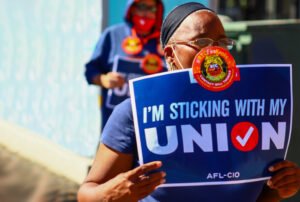The Bush budget is a disaster for nonprofits, not just because of the massive spending cuts, but because the budget plays philanthropy and charity for chumps.
The White House deserves credit for one striking innovation in the proposed FY2006 federal budget. Standing out from all of the remarkable recommendations for slashing and gutting the social safety net was this one: The Bush Administration proposes shifting the government program that addresses childhood obesity from the Department of Health and Human Services (HHS) to Nickelodeon, the Disney Channel, and PBS Kids.
Is this the apotheosis of corporate philanthropy, or the abyss? Late on Friday, February 11th (government agencies typically release bad news on Fridays to ensure minimal Saturday mainstream news coverage), the White House unfurled a 237-page justification for the cuts to and terminations of 154 programs in the FY2006 budget (www.whitehouse.gov/omb/budget/fy2006/pdf/savings.pdf). The justification for eliminating the Center for Disease Control’s Youth Media Campaign against obesity was its alleged redundancy with Disney’s and Nickelodeon’s programs.
Perhaps the Office of Management and Budget (OMB) budget cutters haven’t watched the commercials on Nickelodeon lately to grasp the degree to which the network’s advertising may actually undermine their charitable commitment against childhood obesity—but there is also a deeper meaning that should concern the nonprofit sector.
What we have all worried about has come to pass. The Bush Administration is actively substituting charity and philanthropy for government programs and government spending. Throughout the FY2006 budget proposals, the Administration cites the presence of nonprofit players as examples of excisable redundancy, without a scintilla of awareness that these allegedly “redundant” nonprofits function as the essential delivery systems for government programs to reach their intended beneficiaries: people in need.
One of the more telling examples for community-based nonprofits is in OMB’s “Program Assessment Rating Tool” (PART) review of the Community Development Block Grant program (www.whitehouse.gov/omb/budget/fy2006/pma/hud.pdf). In it, the Administration declares the Community Development Block Grant (CDBG) redundant and duplicative because “other for-profit and non-profits address similar objectives.” News flash for OMB and the White House: many nonprofits share the objectives of the CDBG program because they carry out, with CDBG support, housing and community improvement programs in urban and rural neighborhoods. Without the activities of CDBG-funded community development corporations and others, the revival of many inner city neighborhoods from New York to San Francisco might have staggered, stalled, and died.
Incrementally, the nonprofit sector has let itself be used as the substitute for rather than a supplement to public sector commitment. When the Bush Administration was challenged for its halting and limited governmental response to tsunami relief, the White House and its allies pointed to individual and corporate charitable giving as demonstrations of our public sector generosity. Almost no one complained that charitable giving cannot and should not take the place of our government’s—or any government’s—obligation to address the vast relief and reconstruction needs in Southeast Asia (see “The Tsunami Tsunami,” in the Winter 2004 Nonprofit Quarterly, www.dev-npq-site.pantheonsite.io/section/602.html).
An additional element of budgetary genius is the Bush Administration’s adoption of a strategy approach promulgated in the 1990s by Newt Gingrich in his “Contract for America,” to divide constituencies from their programs, making their elimination all the easier.
Consider the $4.7 billion CDBG program again. CDBG and the Empowerment Zone (EZ) grants administered by the Department of Housing and Urban Development (HUD) and the Community Services Block Grant (CSBG) program in HHS have long histories of community constituencies; that is, these programs were meant to be targeted to and measured against overall community improvement and progress, and therefore had community-based constituencies. In the proposed FY2006 federal budget, the Administration combines CDBG, EZs, CSBG, and 15 other programs (perhaps more, depending on the inadequate navigational tools in the published budget documents), shifts them from HUD and HHS to the Department of Commerce with an emphasis on individual business assistance, and slashes the total budget to $3.7 billion, including a 50% cut in the CDBG component.
Sign up for our free newsletters
Subscribe to NPQ's newsletters to have our top stories delivered directly to your inbox.
By signing up, you agree to our privacy policy and terms of use, and to receive messages from NPQ and our partners.
The shift from HUD and HHS to Commerce wasn’t an efficiency move. It was meant to rip these programs away from their community constituencies and place them in an arena of interest groups wrestling each other in a rugby-like budgetary scrum.
While the Bush budget lays waste to the social safety net, it does offer a few charitable palliatives for the nonprofit sector—if we all turn a blind eye to the context. The budget includes charitable giving incentives such as tax-free withdrawals from IRAs for charitable contributions (costing the federal treasury some $1.6 billion between 2005 and 2010 in lost revenues) plus enhanced deductions for contributions of food, contributions of stock by S corporations, and incentives for businesses to contribute computer technology (www.treas.gov/offices/tax-policy/library/bluebk05.pdf). Although it’s missing in the FY2006 revenue proposals, the President’s Senate allies, led by Rick Santorum, Bill Frist, and Mitch McConnell, included the non-itemizer charitable tax deduction proposal in their January introduction of S.6, the so-called Family and Community Protection Act of 2005. They did this despite reports from the nonpartisan Congressional Budget Office (www.cbo.gov/ftpdocs/40xx/doc4008/12-13-CharitableGiving.pdf) and the Center for Budget and Policy Priorities (www.cbpp.org/3-21-02tax.pdf) that expressed qualms about the non-itemizer’s effectiveness and cost.
The Bush Administration also proposes consolidating and reducing the private foundation excise tax to a flat 1%, without any requirement for changes in foundation grantmaking levels or the composition of foundations’ qualified distributions, on the assumption that this change will spur higher levels of foundation grantmaking. There is simply no empirical evidence to support this, as the vast majority of private foundations hew to the 5% spending floor as a nearly impenetrable ceiling. Bush allies in the Senate have a proposal in S.6 concerning foundations holding increased concentrations of corporate stock, but with no provisions in the legislation for any increased foundation grantmaking.
The fact that S.6 combined these minor charitable giving incentives with key elements of the conservative ideology behind the current administration (including continuing restructuring of welfare [TANF], so-called “healthy marriage” programs, and expansion of the Administration’s faith-based grants [the Compassion Capital Fund]) underscores the need to see the charitable giving proposals in context—as more of the cover from the federal government’s withdrawal from funding social safety net programs. The willingness of some national nonprofit leaders to turn a blind eye to the Administration’s intent as they flirt with key legislators to get pieces of the charitable giving proposals enacted is politically myopic at best, but ultimately delusional and destructive to the interests of the nonprofit sector and the people served by nonprofits.
The FY2006 budget justified cuts in some instances, for example with CDBG and CSBG, by citing supposedly documented inefficiency and waste in the programs, partly through grants to cities and nonprofits that have done poorly in making the most of these precious resources, and partly because of the willingness of nonprofits to work with Congressional allies to negotiate performance-proof earmarks from these programs. The nonprofit sector has to fight for these programs to be retained, refunded, and even exp anded, and at the same time struggle against their misuse by unscrupulous characters whose inappropriate and ineffective administration of the funds simply helps the White House and Congress mischaracterize entire programs based on the inappropriate behavior of a few.
The Administration characterizes its cuts and consolidations in these programs and others (including rural community facilities, comprehensive school reform grants, and migrant and seasonal farm worker programs), which are cloaked with charitable giving incentives, as “supporting a compassionate society.” It specifically names its shifting of community programs away from community emphases and constituencies as the “Strengthening America’s Communities” initiative (http://www.whitehouse.gov/omb/budget/fy2006/commerce.html) Neither of these p.r.-oriented tag lines can obscure the destructive impact the Bush Administration’s programs will have on services delivered by nonprofits for underserved, disadvantaged, disenfranchised communities.
The nonprofit and philanthropic sectors have to stop selling themselves out for pennies of charitable giving while the Bush Administration guts critical governmental spending for needy communities. By playing up to the Bush White House and Congressional allies for meager incentives, the leadership of the nonprofit sector is being played for chumps—but it is the future of urban and rural communities that is being wagered and lost.
Rick Cohen is the executive director of the National Committee for Responsive Philanthropy (www.ncrp.org).













